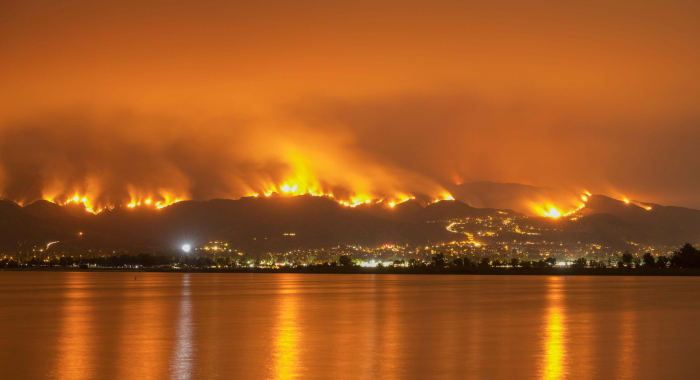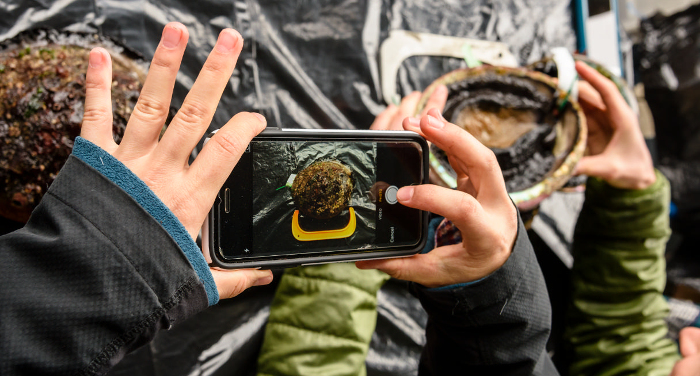Technology is enabling conservation scientists to collect and analyze data with an efficiency unimagined just decades ago. Satellite and drone-based remote sensing allow rapid mapping and monitoring of environmental conditions; networked sensors such as camera traps and flow meters provide real-time data about the health and potential threats to important resources.
Data are fundamental to making science-based conservation decisions. By modernizing environmental data capture and analysis and streamlining the delivery of usable information to decision makers, we can unlock new opportunities for transformative change in resource management.
The Conservancy’s team of designers, engineers, and data scientists are continually applying new applications of technology to increase the pace and scale of conservation in California – and beyond.


Kirk Klausmeyer, Bronwen Stanford, Nathan Enerson, Steven Sonvisen, Falk Schuetzenmeister, and Jam Hamidi
To protect water for nature, we first need to understand current flow conditions in our rivers, and how that flow is altered from natural conditions. Under the California Environmental Flows Framework…Jennifer Carah, Ben Kerr, Mia van Docto, Anders Farr, Kirk Klausmeyer, Steven Sonvisen, Siena Testa, and Jam Hamidi
Water is essential for California’s people, economy, and environment, yet water availability for people and nature is not well understood. This tool efficiently assesses water availability in…Lara J. Brenner, Nathaniel Rindlaub, Juliana Matos, Scott Meyler, Sue Pollock, Falk Schuetzenmeister, Nick D. Holmes
Invasive mammals like rats pose a major threat to island ecosystems and endemic species. This study tests a wireless camera network on Santa Cruz Island that uses AI to detect nonnative mammals in…Alexandra L. DeCandia, Jasmine Lu, Emily E. Hamblen, Lara J. Brenner, Julie L. King, Calypso N. Gagorik, Juliann T. Schamel, Stacy S. Baker, Francesca J. Ferrara, Melissa Booker, Andrew Bridges, Cesar Carrasco, Bridgett M. vonHoldt, Klaus-Peter Koepfli, Jesús E. Maldonado
Isolated island species may be more susceptible to disease because of their lack of genetic diversity. Santa Catalina Island foxes have the highest rate of cancer ever measured in wildlife - over 50%…Samantha Pasciullo Boychuck, Lara J. Brenner, Calypso N. Gagorik, Juliann T. Schamel, Stacy Baker, Elton Tran, Bridgett M. vonHoldt, Klaus-Peter Koepfli, Jesús E. Maldonado, Alexandra L. DeCandia
On California’s Channel Islands, two rare carnivores—the island fox and island spotted skunk—have coexisted for millennia despite competing for similar resources. This study explores…Bruce Markman, H. Scott Butterfield, Janet Franklin, Lloyd Coulter, Moses Katkowski, and Dan Sousa
Residual dry matter has been widely used to monitor grazing impacts across conservation grazing lands for more than 75 years, largely done with time-intensive, expensive, and hard-to-reproduce…Nisi A, H Welch, S Brodie, C Liephardt, R Rhodes, E Hazen, JV Redfern, TA Branch, A S Barreto, J Calambokidis, T Clavelle, L Dares, A de Vos, S Gero, J A. Jackson, RD Kenney, D Kroodsma, R Leaper, DJ McCauley, SE Moore, E Ovsyanikova, S Panigada, CV Robinson, T White, JR Wilson, B Abrahms
Collisions between whales and ships are a leading cause of death for threatened whale species across the globe. In this paper, scientists identified high risk areas for whale-ship collisions by…Christopher M. Free, Camila Vargas Poulsen, Lyall F. Bellquist, Sophia N. Wassermann, Kiva L. Oken
Commercial and recreational fisheries in California influence a long and dynamic history of coastal economies, cultural heritage, and marine ecosystem health. Fisheries-dependent data sources are…Naomi S. Fraga, Brian S. Cohen, Andy Zdon, Maura Palacios Mejia, Sophie S. Parker
This paper presents novel botanical inventories of 48 desert springs as part of the Mojave Springs Research Project. The authors assess plant species composition and richness within and between…Grace C. Wu, Ryan A. Jones, Emily Leslie, James H. Williams, Andrew Pascale, Erica Brand, Sophie Parker, Brian Cohen, Joseph Fargione, Julia Souder, Maya Batres, Mary G. Gleason, Michael H. Schindel, Charlotte K. Stanley
This paper presents the results of the Power of Place-West project. The authors combined energy modeling with ecosystem and wildlife habitat data to determine the costs and impacts associated with…Vienna R. Saccomanno, Tom Bell, Camille Pawlak, Charlotte K. Stanley, Katherine C. Cavanaugh, Rietta Hohman, Kirk R. Klausmeyer, Kyle Cavanaugh, Abby Nickels, Waz Hewerdine, Corey Garza, Gary Fleener, Mary Gleason
Kelp forests are complex underwater habitats that provide valuable services for both people and nature. Despite their importance, increasingly severe stressors have resulted in declines in kelp…Maura Palacios Mejia, Connie Rojas, Emily Curd, Mark Renshaw, Kiumars Edalati, Beverly Shih, Nitin Vincent, Meixi Lin, Peggy Nguyen, Robert Wayne, Kelsey Jessup, Sophie Parker
This paper presents results from a study conducted at TNC’s multi-benefit stormwater management and habitat enhancement project site adjacent to the Los Angeles River. Due to a history of…Daniel Sousa, Frank W. Davis, Kelly Easterday, Mark Reynolds, Laura Riege, H. Scott Butterfield, Moses Katkowski
This paper details a first of its kind approach to land classification, using random forests and multivariate regression trees and historical Landsat satellite imagery to map and then assess changes…Sophie S. Parker, Linnea S. Hall, Mary J. Whitfield, Laura Riege, Kathryn R. Selm, René Corado
This paper presents results from a field-based study that can be used to benefit songbirds in riverside habitats like those found along the Santa Clara River in Ventura County, California. Songbirds…Heather Tallis, Joe Fargione, Edward Game, Rob McDonald, Leandro Baumgarten, Nirmal Bhagabati, Rane Cortez, Bronson Griscom, Jonathan Higgins, Christina M. Kennedy, Joe Kiesecker, Timm Kroeger, Trina Leberer, Jennifer McGowan, Lisa Mandle, Yuta J. Masuda, Scott Morrison, Sally Palmer, Rebecca Shirer, Priya Shyamsundar, Nicholas H.Wolff, and Hugh P. Possingham
Spatial analysis is a powerful tool in conservation planning. Yet it is often under-deployed as a means of elucidating which conservation actions may deliver the highest return on investment. This…D. Richard Cameron, Carrie A. Schloss, David M. Theobald, Scott A. Morrison
Protecting or restoring habitat connectivity in landscapes undergoing rapid environmental change requires multiple conservation and restoration strategies. These strategies have different risk…Hyeyeong Choe, Annika T.H. Keeley, D. Richard Cameron, Melanie Gogol-Prokurat, Lee Hannah, Patrick R. Roehrdanz, Carrie A. Schloss, James H. Thorne
Planning for connectivity conservation often relies on modeled movement routes. However, these pathways can be sensitive to the conservation objective, modeling approach, analysis tool, and…Carrie Schloss, Liz O’Donoghue, Dan Rademacher, Patric Huber, Jodi McGraw, Kim Becerril, Janine Knapp
Every year, infrastructure agencies and developers spend hundreds of millions of dollars to mitigate for impacts to sensitive species and habitats. These mitigation sites are often piecemeal projects,…Carrie A. Schloss, D. Richard Cameron, Brad H. McRae, David M. Theobald, and Aaron Jones
Plant and animal species are already shifting their ranges in response to a changing climate. Maintaining connectivity between present habitat and suitable habitat in the future will become…